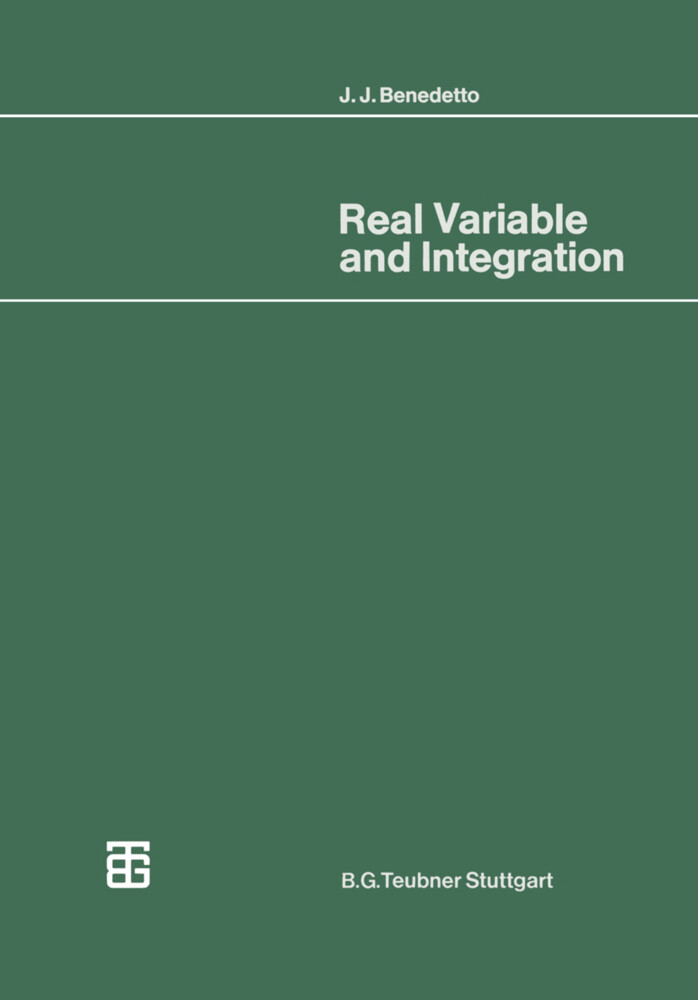
Zustellung: Do, 05.12. - Mo, 09.12.
Versand in 3 Tagen
VersandkostenfreiBestellen & in Filiale abholen:
The subject matter in this book is a fundamental part of the basic graduate real variable course as I now teach it. Since there are several excellent texts that generally cover the material here, I'm obliged to render an "apologia" for the present text con cerning its content, presentation and existence. The theme of this book is the notion of absolute continuity and its role as the unifying concept for the major results of the theory, viz., the Lebesgue dominated convergence theorem (LDC) and the Radon-Nikodym theorem (R-N). The main mathematical reason that I've written this book is that none of the other texts in the area stresses this issue to the extent that I think it should be stressed. Let me be more specific. The problem of taking limits under the integral sign, that is, "switching limits", is in a very real sense the fundamental problem in analysis. Lebesgue's axiomatization which formulates and proves LDC in an optimal way yields the most important gene ral technique for examining such problems. This material is developed in Chapter 3. Shortly after Lebesgue's initial work Vitali gave necessary and sufficient conditions to switch limits in terms of uniform absolute continuity. Vitali's result led to research which has culminated in Grothendieck's study of weak convergence of measures. This latter material is usually not included in most texts; in particular, its relationship to LDC is not emphasized. This is the reason that I've included Chapter 6.
Inhaltsverzeichnis
1 Classical real variable.- 1.1 Set theory a framework.- 1.2 The topology of R.- 1.3 Classical real variable motivation for the Lebesgue theory.- 1.4 References for the history of integration theory.- Problems.- 2 Lebesgue measure and general measure theory.- 2.1 The theory of measure prior to Lebesgue, and preliminaries.- 2.2 The existence of Lebesgue measure.- 2.3 General measure theory.- 2.4 Approximation theorems for measurable functions.- Problems.- 3 The Lebesgue integral.- 3.1 Motivation.- 3.2 The Lebesgue integral.- 3.3 The Lebesgue dominated convergence theorem.- 3.4 The Riemann and Lebesgue integrals.- 3.5 Some fundamental applications.- Problems.- 4 The relationship between differentiation and integration on R.- 4.1 Functions of bounded variation and associated measures.- 4.2 Decomposition into discrete and continuous parts.- 4.3 The Lebesgue differentiation theorem.- 4.4 FTC-I.- 4.5 Absolute continuity and FTC-II.- 4.6 Absolutely continuous functions.- Problems.- 5 Spaces of measures and the Radon-Nikodym theorem.- 5.1 Signed and complex measures, and the basic decomposition theorems.- 5.2 Discrete and continuous, absolutely continuous and singular measures.- 5.3 The Vitali-Lebesgue-Radon-Nikodym theorem.- 5.4 The relation between set and point functions.- 5.5 Lp?(X), l?p??.- Problems.- 6 Weak convergence of measures.- 6.1 Vitali s theorems.- 6.2 The Nikodym and Hahn-Saks theorems.- 6.3 Weak convergence of measures.- Appendices.- I Metric spaces and Banach spaces.- I.1 Definitions of spaces.- I.2 Examples.- I.3 Separability.- I.4 Moore-Smith and Arzelà-Ascoli theorems.- I.5 Uniformly continuous functions.- I.6 Baire category theorem.- I.7 Uniform boundedness principle.- I.8 Hahn-Banach theorem.- I.9 The weak and weak topologies.- I.10 Linearmaps.- II Fubini s theorem.- III The Riesz representation theorem (RRT).- III.1 Riesz s representation theorem.- III.2 RRT.- III.3 Radon measures.- III.4 Radon measures and countably additive set functions.- III.5 Support and the approximation theorem.- III.6 Haar measure.- Index of proper names.- Index of terms.
Mehr aus dieser Reihe
Produktdetails
Erscheinungsdatum
01. Juni 1976
Sprache
deutsch
Auflage
1976
Seitenanzahl
284
Reihe
Mathematische Leitfäden
Autor/Autorin
John Benedetto
Co-Autor/Co-Autorin
John Benedetto
Verlag/Hersteller
Produktart
kartoniert
Abbildungen
II, 278 S.
Gewicht
495 g
Größe (L/B/H)
244/170/16 mm
Sonstiges
Paperback
ISBN
9783519022091
Entdecken Sie mehr
Bewertungen
0 Bewertungen
Es wurden noch keine Bewertungen abgegeben. Schreiben Sie die erste Bewertung zu "Real Variable and Integration" und helfen Sie damit anderen bei der Kaufentscheidung.

































